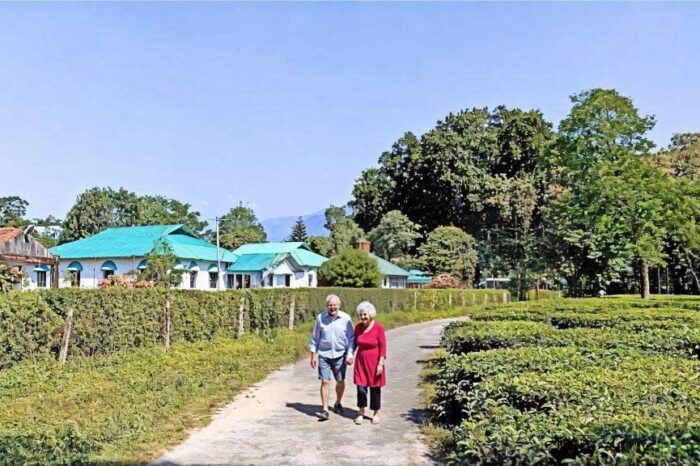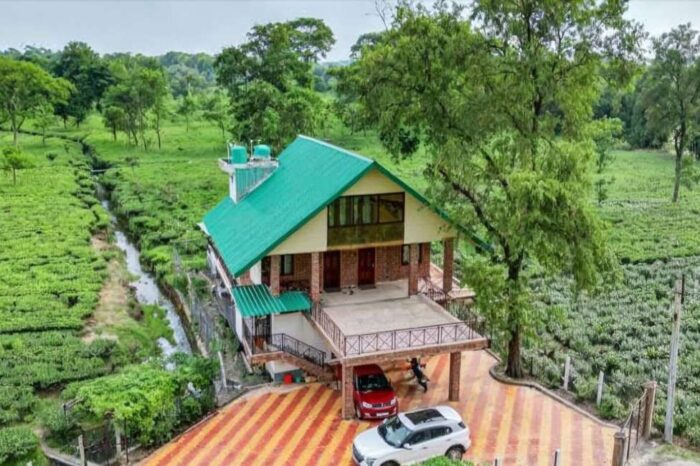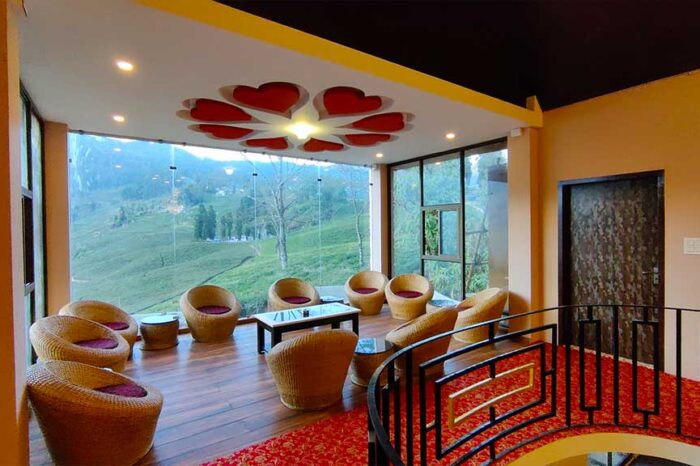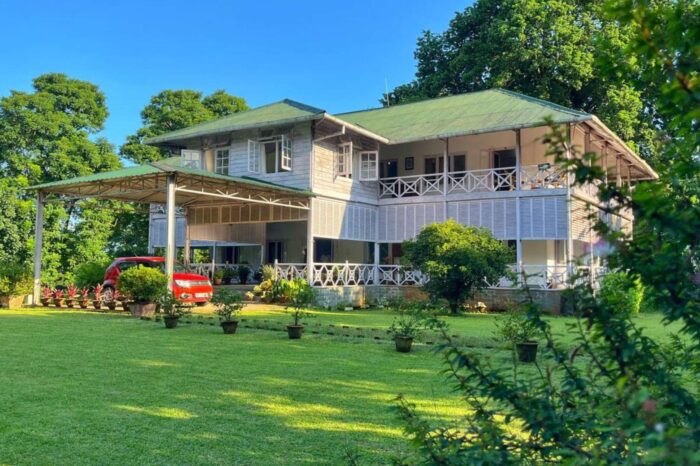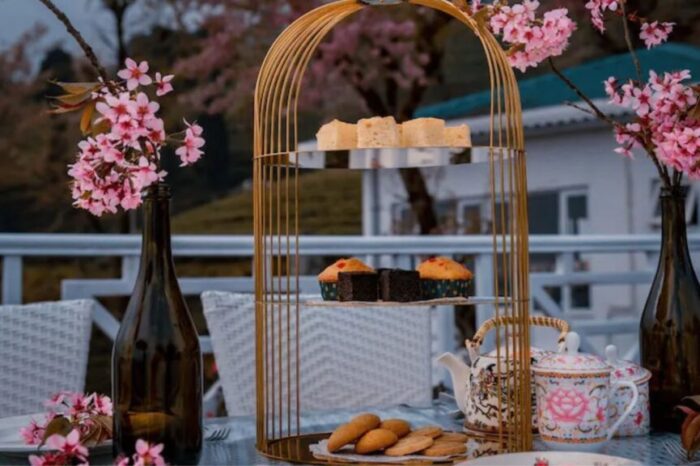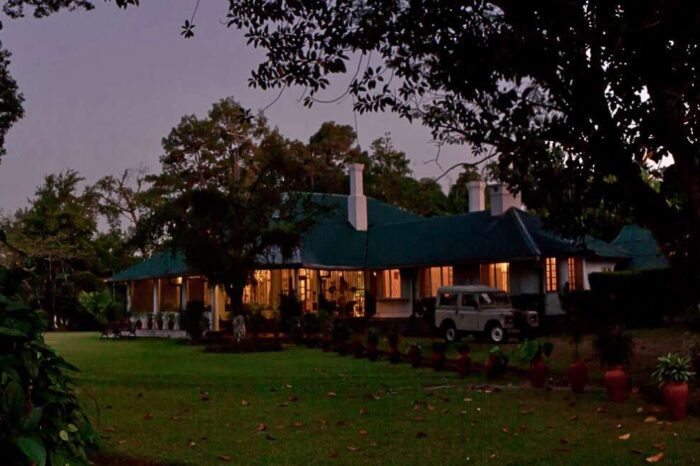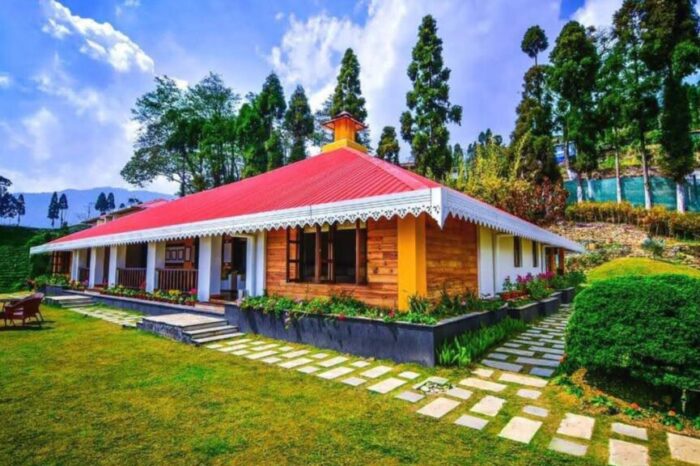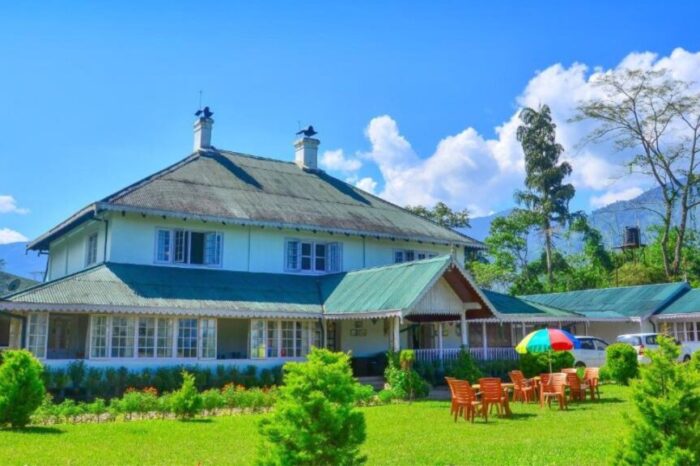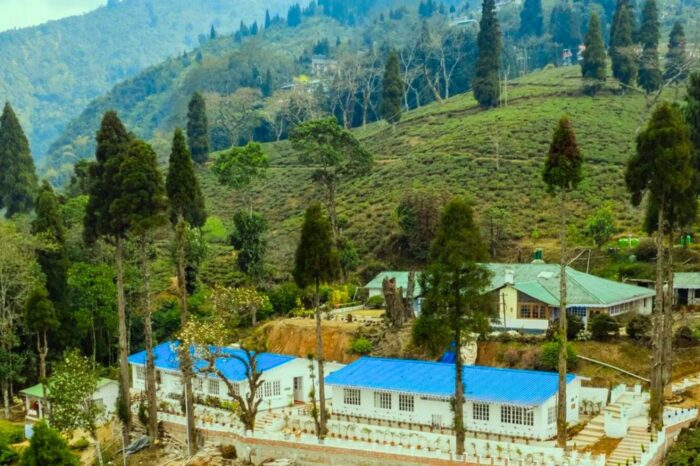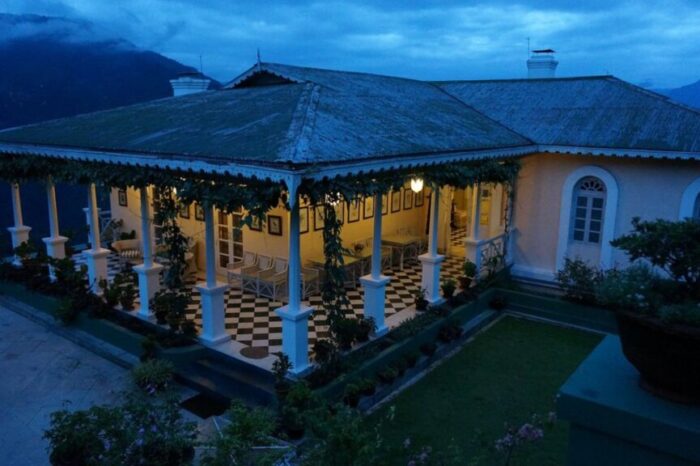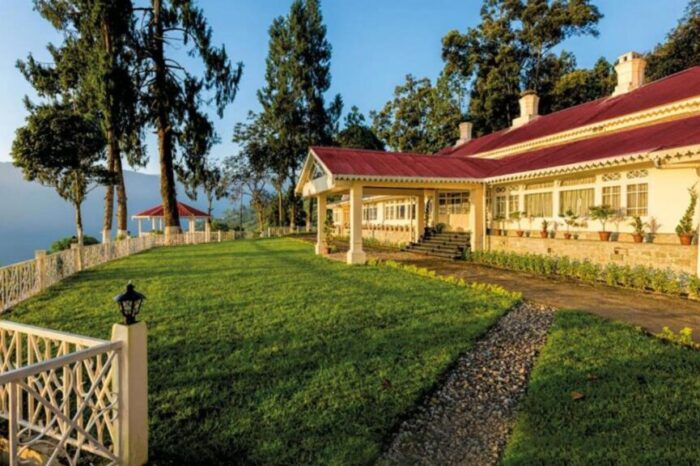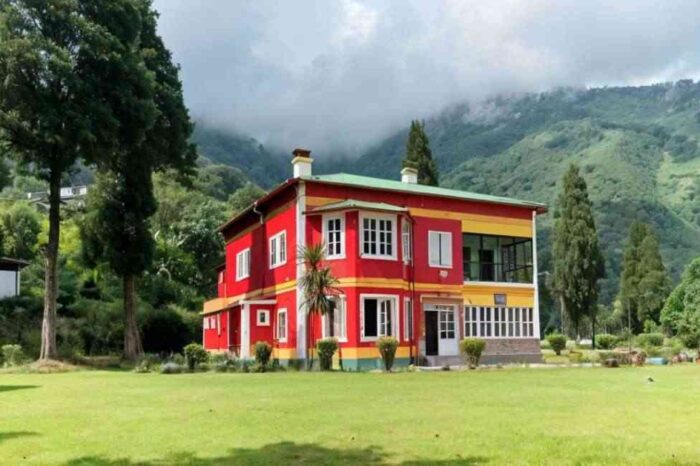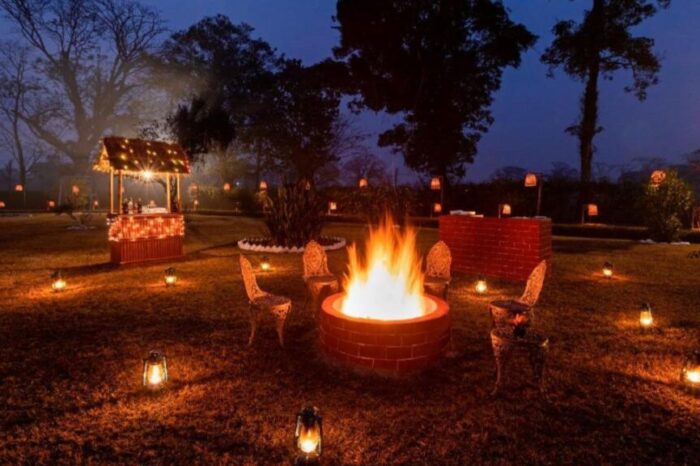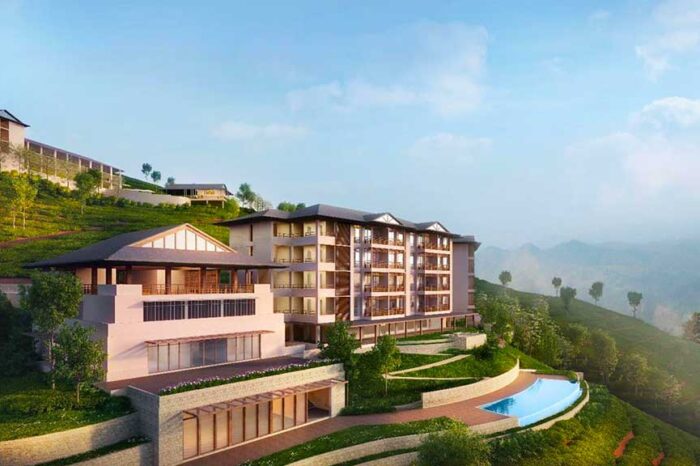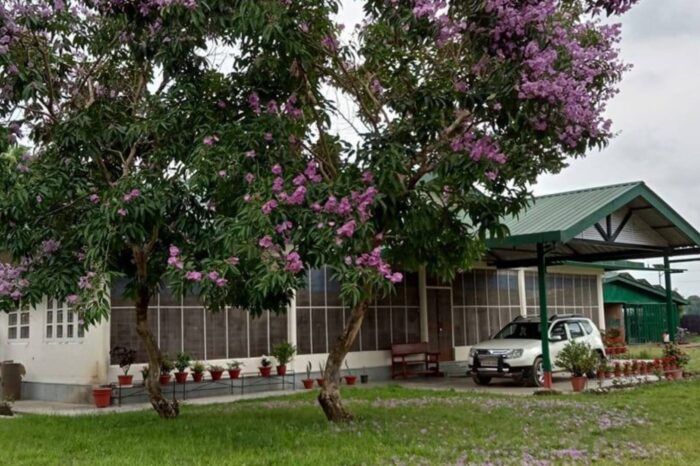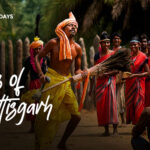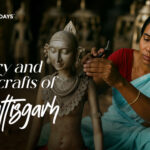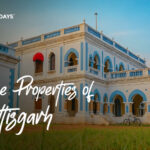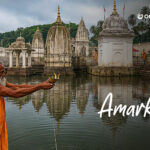- Home
- INDIA
- Offbeat India
- International
- Theme Tours
- Blogs
- Case Studies
- Plan Your Trip
Tea Tourism
Tea tourism invites you to explore the captivating world of lush tea plantations and their rich heritage. Immerse yourself in the serene beauty of rolling green landscapes, learn the intricate art of tea cultivation, and indulge in the refreshing aroma […]
Tea tourism invites you to explore the captivating world of lush tea plantations and their rich heritage. Immerse yourself in the serene beauty of rolling green landscapes, learn the intricate art of tea cultivation, and indulge in the refreshing aroma of freshly brewed tea. Tea tourism is perfect for nature enthusiasts, tea lovers, and anyone seeking a peaceful retreat, blending culture, nature, and tranquility in an unforgettable journey.
Top Tea Tourism Destinations of India
A flavourful journey
Ever fancied indulging in a cup of premium tea amidst lush green tea gardens? Travelling just to enjoy this bliss is catching up as a trend, and India surely isn’t left behind.
The country ranking 2nd in the world regarding tea production has sprawling tea gardens clustered on the slopes of its North-eastern Himalayas and the Nilgiris in the south. Based on these regions, tea tourism has flourished motivated by a deep interest in the history, heritage, and consumption of tea.
A journey along these famous tea trails will allow you to experience this rich culture. You will not only get to learn fascinating facts about tea plantation but also pamper your senses with the choicest of tea brewed with tea leaves plucked freshly from the garden.
A Rendezvous with India’s Tea History
India’s romanticism with tea or ‘chai’ (as it is lovingly known as) dates back to around 750-500 BCE. Just like the history of any famous food or beverage, the origin of tea is also shrouded in contradictions. While some people say it was discovered by accident, others opine it came all the way from China. Nonetheless, tea has transcended through the ages and contradictions to become the most loved beverage of the country. Today, no matter where in India you are, you’re probably never too far away from a good old cup of tea. It is that ubiquitous and hence, a prized heritage.
Prospects of Tea Tourism in India
Tea tourism is a special branch of gastronomy tourism that promises global tourists a unique, wholesome experience. It has emerged as a recent niche in India’s tourism scenario but is catching up fast on popularity. This was expected given the fact that North East India, the tea corridor of the subcontinent, contributes a significant percentage of the world’s total tea production. Assam, specifically, is the second highest tea producing region in the world after China whereas Darjeeling tea tops the world in flavour and quality. The individual tea plantation areas in Assam, Dooars-Terai and Darjeeling total at 3, 12,210 ha, 97,280 ha, and 19,000 ha (aggregated) respectively.
There has been a great deal of enthusiasm among tea estate owners to promote tea tourism since the 1990s. Of late, the government too has joined hands to boost the historic industry and promote tourism globally. Last year, in September, Assam Chief Minister Mr. Sarbananda Sonowal laid the foundation stone of the Tea Tourism Hub at Jorhat’s Tocklai Tea Research under the state government’s ‘Uttaran’ Scheme. The Hub aims to develop tourism infrastructure while training small tea growers of the state side by side.
West Bengal too is looking at similar projects. On International Tea Day 2018, Chief Minister Mamata Banerjee promised to consider tea tourism to boost tea plantation in the state.
What to Expect in a Tea Tour in India?
Tea tourism encompasses a bouquet of activities. Whether you’re a tea connoisseur or not, a tea tour in India is sure to invigorate you with its fascinating experiences.
Some of the typical tour highlights include:
- Exploring famous tea gardens
- Learning about plucking tea leaves
- Tasting finest varieties of tea
- Visiting nearby tea factories and learning about tea production
- Attending tea tasting and tea brewing sessions
- Engaging in tea talks
- Visiting nearby landmark places
- Day excursion to nearby hill stations and other tourist spots
- Nature Walks/Trekking through hilly roads and nature reserves
- Hiking and camping
- Fishing/Angling
- River rafting
- Bird-watching, butterfly-watching
- Enjoying a luxurious stay at in a tea resort/bungalow
- Witnessing song and dance performances of tribal people/native performers
- Playing indoor games like table tennis, snooker, carom etc.
- Playing a piano or reading books in the in-house library
- Attending cooking/baking classes
- Enjoying spa, beauty and/or a massage session
The off-beat itinerary packs in more surprises and excitement. You must embark on a tea tour in India to know what all it has in store for you!
Major Tea Tourism Sites in India
The prominent tea producing regions in India where tea tourism has fledged in the recent years are:
- West Bengal
- Darjeeling
- Dooars and Terai
- Assam – Jorhat
- The Nilgiris
- Munnar – Kerala
- Ooty – Tamil Nadu
- Conoor – Tamil Nadu
- Himachal Pradesh – Palampur
Tea Tourism in Darjeeling
Where brews the iconic Orange Pekoe…
Darjeeling may be a collage of emotions to most Indians, but to the world, it is a place which is synonymous with tea- the finest that is! The undulating green hills, the murmuring streams, the colourfully dressed women gently plucking the famous two leaves and a bud, and the colonial bungalows sitting gracefully on the slopes- paint a picture that speaks all about Darjeeling’s umbilical bond with tea.
There are 87 tea gardens in Darjeeling district stretching southward up to Kurseong and Mirik. The entire region produces 8-8.5 million kg of tea annually, which is less than 1% of India’s total tea production. Yet, Darjeeling tea is known as the ‘Champagne of teas.’ During February-March every year, when the first flush from the garden hits the market, buyers from all over the world form a beeline to get a carton of it. And that too at a premium price!
Intrigued what’s so special about Darjeeling tea? Spend a few days in one of the exclusive Darjeeling tea gardens and you will be able to decode the mystery and magic of the amber coloured ambrosia.
1. Glenburn Tea Estate
Sprawling in 1600 acres of land, Glenburn is a heavenly tea retreat in Darjeeling. It is perched atop a hill overlooked by the mighty Kanchenjunga. Dense forests, rolling hills, verdant tea gardens, quaint tea pickers’ villages, and a pair of river valleys abound in the Glenburn Tea Estate.
An attic in the Heaven
Perched atop a hillock overlooking River Rungeet, the 1,600 acres of sprawling tea estate is a jewel in Darjeeling’s tea tourism map. It was started in 1859 by a Scottish tea company but was later passed onto India’s pioneering ‘Chaiwala family’- The Prakashes. They have since nurtured the property taking its hospitality to new heights. Today, Glenburn is a sought-after tea destination in India attracting tourists from all corners of the world.
The Scenic Beauty of Glenburn
Glenburn Tea Estate is like a piece of heaven on earth. The mighty Kanchenjunga stands on the horizon. The snow-fed Rungeet and Rung Dung rivers flow some 800 ft down the hillock. There is a forest hemming the river banks and a river-side campsite lodge- all within the estate. Plus, there are two opulent bungalows oozing elegance and old-world charm. All the eight suites in the two bungalows offer stunning views of the Darjeeling Himalayas and tea gardens making the place an ideal retreat for today are discerning travellers.
The Glenburn Experience: The Perfect Blend of Luxe Leisure and Activity
Glenburn Tea Estate is a compelling blend of natural beauty, sophisticated luxury, and an unmissable opportunity to witness tea production right in the lap of Darjeeling tea gardens. The tranquillity and serenity are simply unmatched. But what makes the estate even more coveted is the warm hospitality ensured by its hosts. They not only pamper you throughout your stay but also join you at the meals, accompany you on the nature walks, and share with you their knowledge on tea plantation during specially conducted tea tours.
The tour begins with an in-depth audio-visual presentation on Glenburn’s history and ends with a tea tasting session. In the session, you get the opportunity to taste a wide variety of teas ranging from black, green and oolong teas to white tea while discovering the intricate differences in aroma, flavour, and the appearance of various tea leaves.
A vacation at Glenburn Tea Estate often turns out to be a gastronomical delight for travellers because all the meals served here are prepared using their own farm-fresh fruits and vegetable. Therefore, they are safe and full of natural goodness.
Besides, all modern, high-end amenities are available here that make your stay really comfortable and worth remembering.
The Specialty of Glenburn Tea
The experience of savouring a cup of premium Darjeeling tea in Glenburn Tea Estate is surreal, to say the least. The flavour, which is the king, they say, has evolved through years through the cross-breeding of the best of varieties of tea cultivated in the Himalayas. In one of Glenburn official’s words, “The strength of the old and the vitality of the young – the future of Glenburn is Colonial Tea!”
Bird Watching and Butterfly Trail in Glenburn
A self-contained tea tourism destination, Glenburn is home to a large variety of trees, wildflowers, birds, butterflies, and honeybees. During your stay here, you can go on nature walks and indulge in bird or butterfly watching. Some of the rare birds found in the estate are Red Jungle fowl, Yellow-Rumped Honeyguide, Eurasian Wigeon, Grey-crested Pygmy Woodpecker and Barbets, etc. The butterfly species adorning the place are Red Breast Basking, Glassy Blue Bottle, Crimson Rose, Red Spot Jezebel, and Paris Peacock, etc.
Other Activities
During your stay at Glenburn, you can also indulge in other activities like:
- Hiking
- Fishing in Rungeet and Rung Dung river
- Day trip to Darjeeling and/or Kurseong
- Cookery classes
- A relaxing massage or beauty treatment
How to Reach?
Glenburn Tea Estate is about 1 hour 15 minutes’ drive away from Darjeeling town and 3 hours from Bagdogra Airport, Siliguri. You can either follow the River Teesta route or take the Darjeeling bound road upon reaching the bridge (that connects West Bengal to Sikkim) before driving down to Glenburn. Or, you can drive through Kurseong town and the outskirts of Darjeeling before veering off towards Glenburn.
Chartered helicopter service is also available on request from Bagdogra, New Jalpaiguri Station, Darjeeling, Kalimpong, Gangtok, Pelling, Phuentsholing (Bhutan) and Bhadrapur (Nepal).
Best Time to Visit
- There are very few places on earth where you can visit at any time of the year. Glenburn is one such place in India. It remains accessible and welcoming to its visitors all through the year. Plan your visit as per your tea preference.
- Spring (February-March): Tea leaves plucking (First Flush)
- Summer – Second Flush
- Monsoon – Rain teas
- End of November – Autumn Flush
- December-January – Tea plant pruning
The scenic beauty and the exclusiveness of Glenburn make every visit worth it, irrespective of the time. Add to it, the special value-additions and hospitality and you get a vacationing experience of a lifetime.
2. Sourenee Tea Estate & Boutique Resort
Sourenee is a tea trove boasting 100 years of tea plantation history. It offers a panoramic view of the Himalayas and pristine valleys Nepal and Mirik. The stay at the luxurious bungalow, the tea tours and the activities make Sourenee a favourite tea tourism spot in Darjeeling.
A Magical Getaway in the Tea Gardens of Darjeeling
Located at a height of 4500 ft. from the sea level and surrounded by lush green tea gardens, Sourenee Tea Estate is one of the premier tea tourism destinations in Darjeeling. It boasts a rich tea producing history of 100 years! Over the years, the estate has been producing quality Darjeeling tea and therefore, holds a special place in India’s tea tourism map.
The place offers a panoramic view of the Himalayas, rolling valleys of Mirik and Nepal, and the shimmering mountainous streams. The three-storied plush bungalow that sits at the middle of the estate is an embodiment of old-world charm, and its eight exclusive rooms- a haven of luxury each. Every corner of the property exalts the Indian heritage and the impeccable hospitality makes each moment of your stay so fulfilling that you feel like coming back again and again.
The Sourenee Experience: Tea and More!
Holidaying in Sourenee is all about soaking in the tranquillity and feeling rejuvenated by the fresh aroma of tea. A typical day at the resort starts with you waking up to the breathtaking morning view of the snow-capped Kanchenjunga. The breakfast that follows is an elaborate affair with a wide variety of delightful dishes accompanying the most flavourful teas.
Sourenee is a trove of premium tea and tea tales! It has been producing organic tea since 2009. So, it is obvious that you will get to taste the choicest blends of organic tea while staying here. In addition to tasting the estate originals- the First Flush, Second Flush, Rain Flush, and Autumn Flush, you also get to learn about the art of plucking tea leaves and then watch the leaves being processed into ready-to-package tea. As a memento, you can take along with yourself packaged black tea, green tea, selected whole leaf grade teas, and specialty teas such as Black Blossom, Silver Green, and Oolong Tea.
Apart from Tea Tasting, You Can Indulge in a Number of Activities at the Estate. The Activities Include:
- Picnicking at a nearby scenic location – the staff makes all the arrangement for you
- Trekking through one of 7 picturesque mountainous trails
- Day excursion to Mirik and Darjeeling
- Fishing and angling
- Local sightseeing and visit to the monasteries
- Wildlife safari in the sanctuaries
- Horse riding and boating in Mirik
The Highlights
The internationally acclaimed certification body, Control Union Certifications has accredited Sourenee Tea Estate for having completed the Organic Certification Process. The other certifications owned by the estate include DNV certified Hazard Analysis & Critical Point, NOP, NPOP, and JAS.
How to Reach?
Sourenee Tea Estate is located 7km before Mirik on Siliguri-Mirik-Darjeeling highway. The place enjoys excellent air connectivity with major airports of India. From Bagdogra, it takes only one hour in the car to reach Sourenee.
Best Time to Visit
Late autumn and spring are the best times to visit a tea garden. So, plan anytime between the end of October and March and you will have a memorable vacation at one of Darjeeling’s oldest tea tourism spot.
3. Goomtee Tea Garden Retreat
Goomtee Tea Gardens produce the finest varieties of orthodox Darjeeling Tea. Located at 4150 ft height, the place offers breathtaking vistas of mountains, valleys and tea gardens. The heritage bungalow inside the estate is an embodiment of fine hospitality. It promises to make your bespoke tea tour an experience to cherish.
The Organic Tea Trove
At an age when ‘organic’ is grabbing the world’s attention, Goomtee Tea Estate near Kurseong stands high as one of the premium organic tea gardens of India. Spanning across 600-acres of land covering forests, hilly slopes, brooks, and waterfalls, and tea gardens, this place offers a perfect retreat for weary souls and tea connoisseurs alike.
The colonial-era heritage bungalow which has been restored into a plush resort was originally built by Mr. Henry Montogomery Lennox in 1899. In 1956, the property was jointly taken over by Mr. Mahabir Prasad and the Kejriwal family. Today, the bungalow opens its doors to all discerning travellers but the mode of booking is not typically commercial. The present owners prefer inviting only those who sincerely wish to spend a vacation amidst tea gardens and promise to present them a holiday with a difference.
The Bespoke Tea Experience, Facilities, and Activities
The heritage bungalow inside Goomtee Resort, located 4150 ft above the sea level, offers a magnificent vista of the mountains, valleys and tea gardens of Darjeeling. There are 4 tastefully done up rooms in the bungalow, all of which are steeped in elegance and peace.
Outside the bungalow, the lawn is full of greenery and bright flowers. Here, you can take leisurely walks at any time of the day. The clean air, the clear blue sky, the cool breeze, and the aroma of the finest Darjeeling teas will help you to totally unwind. The food experience at Goomtee also deserves a special mention. You are served with a delectable spread of fresh vegetable food (egg items included) accompanied by cups of world-class teas.
Tea Specialty of Goomtee
Goomtee tea gardens produce the finest varieties of orthodox Darjeeling tea. As a guest, you are taken on guided trips to the tea gardens. There you get to experience the fascinating tea-manufacturing process. A tea tasting session is also arranged which helps you gain insight into various types of tea.
The morning tea at Goomtee Bungalow is brewed with tea leaves plucked a day before. You can request a special drink and be served happily.
Other Activities
One can enjoy an array of activities at Goomtee Tea Estate. The most exciting ones are:
- Hiking through the tea gardens on the hilly slopes and interacting with the tea pluckers
- Trekking in Sandakpu and North Bengal
- Toy train ride to Darjeeling
- Sightseeing: Sunrise at Tiger Hill, Zoological Garden, and Himalayan Mountaineering Institute & Museum in Darjeeling
- Exploring markets of Kurseong
- Other recreational facilities within the premises include table tennis and a well-stocked library.
How to Reach?
Goomtee is located 48kms from Darjeeling and 40kms from Bagdogra Airport, Siliguri. Flights to Bagdogra are available from all major airports of the country. If you are coming from outside India, you have to take a connecting flight from Delhi, Mumbai, or Kolkata.
Best Time to Visit
March-June and again from September to January are the best times to visit Goomtee Tea Garden Retreat.
4. Singtom Tea Estate & Resort
Singtom is the world’s oldest tea resort offering the freshest and finest of Darjeeling teas. The luxurious bungalow in the estate promises a memorable stay in the midst 0f nature. This is one place where you do not mind walking 16,00 acres in a day before returning to the comforts of your room.
Where Adventure Meets Tea Romanticism
The world’s oldest tea resort, Singtom in Darjeeling is where tea tourism first began in 1862. The place is steeped in nostalgia. Anyone looking to spend a vacation amidst verdant tea gardens spread across the slopes of mountains and gain a first-hand experience of tea making from farm to cup, then Singtom Tea Estate & Resort is surely the place to be. It takes you back to the roots of tea tourism in Darjeeling and endows you with the knowledge of India’s rich tea heritage.
Looking Back: A Brief History of Singtom Tea Estate
In addition to owning the distinction of being the world’s oldest tea resort, Singtom is also the second oldest tea estate of Darjeeling. It was started by Joachim Stoelke in 1854. Then it was known as Steinthal Tea Estate. Over the years, the ownership of the estate has changed hands before being transferred to the current owners- The Chirimars.
The Singtom Specialties
Singtom Tea Estate & Resort sprawls over 16,00 acres of land. The quaint resort has two types of suites, all offering a spectacular view of the Kanchenjunga. There are century-old fireplaces in each spacious room giving you a feel of a bygone era. The lawn and the walkways are beautifully landscaped with breakfast and sitting arrangements made right in the middle of the tea gardens. The scenic beauty is such that you don’t mind walking all day before returning to the luxurious comforts of your suite.
Top Things to Do in Singtom Tea Estate:
Tea Tasting
Tucked away from the urban hustle and bustle, Singtom gives you a precious opportunity to be one with nature. During your stay here, you can experience the exclusive tea plucking and tea tasting tours. The latter comprises 8 different types of tea (from different regions and of different flushes), each brewed in 2 different ways! The tea factory tour gives you a comprehensive idea about how tea leaves are processed to make the ready-to-package tea.
Other Activities That You Can Enjoy at Singtom Are:
- Picnic at 360 Point
- Picnic at the confluence point of River Teesta and River Rungeet
- Tiger Hill Picnic
- Trekking in 4 trail
- Sightseeing in and around Darjeeling
How to Reach?
Singtom Tea Estate & Resort is a stone’s throw away from Darjeeling town (read 20 minutes). So, it can be easily reached from Bagdogra Airport, Siliguri, which has connecting flights from every major airport in India.
5. Makaibari Tea Estate
Makaibari Tea Estate is one of the oldest tea gardens of Darjeeling and was the first to establish a factory in 1859. Surrounded by hills and streams, Makaibari is the only tea garden of Darjeeling where organic tea Camellia Sinensis is grown in harmony with the primary sub-tropical rain forest.
All About the Bewitching ‘Muscatel’
A quintessential favourite among the world’s ardent tea-drinkers, Makaibari tea is grown in the fertile foothills of the Eastern Himalayas, in Darjeeling district of West Bengal. The tea brand, now routinely featured in one of India’s most circulated English dailies, The Telegraph T2, is the most expensive tea grown in this region. It is sold in premium tea outlets across the globe and earns sizeable foreign revenue for India in exports every year.
Makaibari is more than just a tea estate. It is a heritage well preserved. It is the world’s first tea factory which was built in 1859. Today, it champions the biodynamic method of tea farming along with permaculture. The philosophy of the estate is simple: To sustain the biodiversity of the place through the perfect balancing of every component of nature and retain the magical quality of Makaibari tea through years.
In March 2017, the bungalow of Makaibari tea garden was burnt down by a devastating fire. Now, the estate continues to operate sans the bungalow. People visiting the estate can opt to stay in one of the beautifully maintained homestays and eco huts in Kurseong. Currently, there are 24 families who have extended their homes and hospitality to the tourists of Makaibari Tea Gardens. These homestays are very simple but give you ample opportunity to understand Makaibari’s tea culture and the life of people living in this part of the world.
The Organic, Biodynamic Tea Experience
Ever wondered what goes into making a box of prized ‘Champagne of Tea’ with a five-petal flower logo printed on it? Hard work and artistry. When you see an ad of Makaibari Tea in T2 you hardly think about this. But ask an official of the estate, or for that matter, anyone associated with the tea plantation in Darjeeling, and he will tell you Makaibari tea is the end result of deep passion and years of the sustainable practice of organic tea farming. To experience this endeavour, you must come to Makaibari Tea Estate and stay at one of their impeccable village homestays.
Makaibari primary forest covers twice its entire tea area. It spans four ridges of the tea estate and divides the tea plantation into several islands. The interconnected forests form a large free-land for its denizens to roam about without any fear of breaking the cover. During your stay close to Makaibari Tea Estate, you will get to explore the richness of this biotope in addition to tasting a variety of original Makaibari teas.
Some of the Makaibari specials that you may often come across in your morning Telegraph T2:
- Springtime Bloom
- Summer Solstice Muscatel
- Darjoolong
- Bai Mu Dan
- Organic black tea whole leaf
- Organic black broken
- Organic green fannings
- Organic green tea whole leaf.
Makaibari upholds the importance of tea tourism in Darjeeling aimed at enhancing the sustainability of its community. You must visit the place to see this endeavour up close and witness the “dui path, eksuiro” transforming into a bright, shimmery golden green liquor, brewed with love and subtlety.
How to Reach?
Makaibari Tea Estate is located in Kurseong. It is 40 km from Bagdogra Airport and 38 km from New Jalpaiguri Railway Station. You can reach the spot by car from either Bagdogra or NJP station.
6. Ging Tea House
A pioneer in organic tea farming, Ging Tea Estate is a notable name in the tea tourism map of Darjeeling. It encloses a Tea House built some 150 years ago. The property nestled amidst tea gardens exudes a lot of old world charm and spoils its guests with umpteen dining and recreation options.
Where Serenity Echoes Through the Verdant Valleys
Ging Tea House is one of the largest tea-producing estates of Darjeeling and a pioneer in organic tea farming. It has been certified by the Rainforest Alliance for its initiatives to preserve the ecosystem. The estate encloses a Tea House which was built some 150 years ago. The property has been restored keeping its classical style intact so, when you spend your holidays here, you get to experience its colonial heritage. There are 6 private rooms in the Tea House- all impeccably fitted with modern amenities.
A Day at Ging: Tea Experiences and Activities
A day at Ging Tea House starts with witnessing the sunrise at Tiger Hill gazing over the majestic Kanchenjunga. Then you are served a scrumptious breakfast prepared using local, farm-fresh ingredients. After having your breakfast, you can step out to discover the scenic beauty of the forests filled with stunning flora and the fauna and tune of Nepalese folk songs. The women working in the tea gardens of Darjeeling keeps humming these tunes cheerfully while plucking the tea leaves in their wicker baskets. Stop to sip a blissful cup of Darjeeling tea or join the Ging’s team for a rustic tea picker’s lunch. And then, start for a tour of the tea factory to witness the process of tea manufacturing. Finally, feast your senses to the sight and aroma of the day’s special brews in the specially organized tea tasting session.
Keep the next few days for other exciting activities. Ging offers you access to experiences such as:
- Trekking or hiking along specially curated walking trails
- Day trip to Darjeeling and heritage Toy Train ride
- Indoor activities- playing carom or chess; trying a hand at the piano; reading a book in the library by the cozy warmth of the fireplace.
How to Reach?
Ging Tea House is a half an hour drive from Darjeeling. The nearest airport is Bagdogra in Siliguri. It is well connected to all major metro cities in India. Take a flight to Siliguri and reach Ging by car. It’s just 3-hours’ drive from Bagdogra Airport.
7. Tumsong Chiabari
Located amidst the picturesque hills of Darjeeling, Tumsong Chiabari offers its guests an exclusive ‘chai’ experience. The flaming red rhododendrons everywhere, the exotic forests under the azure sky and miles of undulating green tea bushes make this estate a perfect tea tourism destination in Indi.
Of all the tea garden images that have mesmerized travellers for years, the one with a quaint bungalow nestled amid the rolling hills with whistling breeze sweeping across its backyard is a favourite. Tumsong Chiabari in Darjeeling’s Ghoom with its 186-ha tea area on an open hill slope makes for one such image. It is quiet and peaceful out here with only the chirping of birds, murmuring of the streams, and the happy songs of the tea workers breaking the silence in a rhythmic way. The bungalow has an amazing colonial aura. All the rooms of the property are fitted with modern-day amenities. If you are looking to spend a relaxing holiday combined with some rich tea experience, then Tumsong Chiabari is surely the right destination for you.
The ‘Chai’ Experience at Tumsong Chiabari
Hills, solace, and tea make an awesome combination. They together represent a state of hedonism that is comparable to nothing else on earth. At Tumsong Chiabari, you can experience that in its truest form.
The resort offers you three tour packages, all of which bundle in an exquisite tea experience along with several other activities. You can either choose to relax in the beautiful garden amid feathery white clouds sipping your favourite blend of Darjeeling tea or indulge in some activities.
There Are Options for Outdoor Activities Like:
- Campfire
- Bird watching
- Hiking
- Riverside camping and picnicking
- Trekking
You can also watch live dance performances of Lepcha or Rongpa dancers that the Tea Retreat organizes for its guests around a bonfire in the evening.
How to Reach?
Bagdogra in Siliguri is the nearest airport to Tumsong Chiabari. You can reach Bagdogra by air from any part of India by availing direct or connecting flights. From Bagdogra, you can reach Tumsong by road in 3 hours.
8. Chamong Tea Estate
Chamong basks in an unmatched divinity. Surrounded by lush forests, the 132ha tea plantation area promises tea tourists an experience of a lifetime. It is one of the 17 tea gardens in Darjeeling run by the famous Chamong Group. The tea garden is Naturland and Rainforest Alliance certified.
Chamong, in the lap of Darjeeling Himalayas, is a pristine tea estate that derives its name from the monk-like little birds ‘Chamoo’ (in Lepcha) visiting the place. The entire area around this estate is so serene and peaceful that the Lepcha Buddhist monks find this area ideal for offering their prayers. Most of the estate is under forest cover filled with coniferous trees, wild flowers, birds, and animals.
Only about 132ha of land is used for tea plantation. The tea garden is Naturland and Rainforest Alliance certified and contributes significantly to Chamong Group’s 3000 MT of total annual tea production.
History
The first tea garden of Chamong Group was established in Assam in 1916. The iconic tea plantation owners are now into their 6th generation and own 4 estates in Assam and 17 in Darjeeling. Some of the tea estates in Darjeeling are more than 100 years old; but thanks to the Chamong Group’s modernization efforts, they are all running in full capacity and have gained competitive edge over other tea gardens in the region.
Speciality
Chamong Tea Estate is famous for its organic and flavoured tea leaves. It is the largest producer of organic Darjeeling teas, both in terms of quality and quantity. Tea leaves are handpicked by skilled tea workers and processed with care. The tea varieties produced here are organic green tea, organic black tea, and organic oolong tea.
How to Reach
The easiest way to Chamong Tea Estate is from Bagdogra Airport. It is 37.2 km away from Bagdogra. One can hire a car to Chamong Tea Estate from Bagdogra.
Where to Stay?
There are lots of accommodation options near Chamong Tea Estate but when it comes to luxury, nothing matches the standards of Chamong Chiabari. The enchanting retreat in the lap of the Himalayas smoothly takes you away from the hassles of daily life to an abode of peace and serenity.
Chamong Chiabari is a resort-cum-spa which has three room types: a bungalow overlooking a garden, a suite offering magnificent mountain views, and a Queen room with attached spa bath. Each room is equipped with all the amenities of modern living including a Fulton bed, a mini bar, and a flat-screen TV with cable channels.
Speaking about hospitality, the staff at Chamong Chiabari makes you feel comfortable in the most cordial way possible. From serving them the choicest of menus for breakfast and special meals to those who are on a diet to escorting you on a guided tea tour, they leave no stone unturned to make your stay a memorable one.
The best part of the property is it allows you to bring your pets along with you and it does not charge you anything extra for them! Further, the resort provides all the facilities for its physically disabled guests.
Top Activities
The Chamong Chiabari experience is incomplete without the host of activities it offers. The top activities for the guests staying here include:
- Bird watching
- Mountain treks
- Cycling
- Campfire and barbeque at the lawn
- Dance and music performance by local Lepcha and Nepalese dancers
- Indoor board games and puzzles
- Playground for children
- Books and DVDs (for children)
While staying at Chamong Chiabari you can visit the Ghoom Monastery, Yiga Choeling, Batasia Loop, Darjeeling Mall, and its tea shops, Japanese Peace Pagoda, Tiger Hill, Botanical Gardens, Chowrasta, and Raj Bhavan, etc- all within a day’s trip. Plus, there is this quintessential guided tea garden tour that the estate conducts for its visitors. It allows you to experience nature in its full glory while enriching you with a lot of tea knowledge.
Don’t forget to collect your souvenir from the Chiabari Gift Shop before leaving the tea estate. The keepsake will remind you of the place and nudge you to come back to it again and again.
9. Nuxalbari Tea Estate
Nuxalbari Tea Estate is the first tea garden in Darjeeling to be certified for growing elephant-friendly tea. The estate produces a variety of teas, all handcrafted by master tea artisans. It is a tropical paradise which is home to many birds and wild animals.
Snuggled in the lap of the Eastern Himalayas, Nuxalbari Tea Estate of Darjeeling has many firsts to its credit. It is the first tea garden in Darjeeling to be certified for growing elephant-friendly tea- an initiative to reduce human-elephant conflict. The estate also boasts a wonderful matriarchal lineage. It is a tropical paradise which is home to a large variety of birds and wild animals. Often, animals like leopards, langurs and wild animals cross-forest covered by the1200-acre property. The mystic wilderness along with the lush tea gardens make Nuxalbari a nature lover’s favourite travel destination.
Speciality of Nuxalbari
An interesting history and philosophy of sustainable environmental development are the two things that make Nuxalbari so special.
The tea garden area of Darjeeling, established more than 100 years ago, has stood witness to the Anglo-Bhutanese war in the 19th Century and the Naxalite Revolution in 1967. Today, it is one of the handfuls of tea factories that remain untouched by modernization and automation. In Nuxalbari, teas are still handcrafted by master tea artisans. You can taste the tea if you are travelling there or order it on Amazon.
The main tea varieties produced at Nuxalbari Tea Estate is English breakfast, Lean Green, Calming Tea, and Moroccan Mint, Himalayan Mist 2nd Flush, Dragon Oolong, and Earl Grey.
There are several other tea estates in Darjeeling which are fast becoming tea tourism hotspots. Some of the properties are:
Happy Valley Tea Estate: Owned by Ambootia Tea Group. Here guided tea tours are conducted daily between 9:30 am-4:30 pm. The estate doesn’t provide any accommodation within its premises. However, there is a decent homestay near Happy Valley Tea estate. Other places to stay while on a tour to the tea gardens are:
- Central Heritage Resort & Spa, Darjeeling
- Hotel Orchid Residency
- Mayfair Darjeeling
- Mount Himalayan Resort
- Little Tibet
- Central Gleneagles Heritage Resort
Selim Hill Tea Estate & Retreat: Located in Kurseong and spans over 170 ha of tea plantation area. The tea garden follows biodynamic method of tea plantation. The old Planter’s bungalow offers decent accommodation along with great views of the North-eastern Himalayas and Kurseong valleys. The foot treks and pony treks are interesting activity options within the estate. Other in-house recreation facilities include table tennis room, badminton court, library, and a viewpoint gazebo.
Tea Tourism in Terai-Dooars
Dooars is all about rolling hill slopes, extensive stretches of tea gardens, dense forests, tiny, tranquil villages and their rich culture and customs, fascinating wildlife, and a distant bluish outline of the great Himalayan Range. In Dooars, there are many tea estates which are promoting tea tourism significantly. Although the market is not fully ready yet, there is a huge demand for tea tourism in Dooars alongside mainstream tourism. The tea tourism destinations that are already attracting tourists from all over the world include Octavius Tea Estate, Zurantee Tea Resort, Chalsa Tea Plantation Estate, and Phaskowa tea Estate.
Octavius Tea Estate
Octavius Tea Estate is located in the low lying mountainous terrain of Terai-Dooars. It is surrounded by dense forests and lush tea gardens. Apart from producing conventional teas, Octavius also produces organic and wellness teas using tulsi, mint, ginger, rose leaves, and lemon etc. and a special Chai Masala.
Octavius Tea & Industries Ltd. is a hidden treasure in Dooars that promises you an exotic experience of tea tourism. Apart from producing the conventional tea leaves, Octavius has also specialized in producing organic and wellness tea using Tulsi, Mint, Ginger, Rose leaves, Lemon, etc in the blend. They also produce a special Chai Masala which adds a special zing to the tea.
In addition to enjoying the specially guided tea tours, one can engage in the following activities near Octavius:
- River Rafting
- Trekking
- Mountaineering, mountain biking, paragliding
- Jungle safaris in the Buxa Tiger Reserve and Gorumara National Park
- Bird watching in Suntalekhola Bird Sanctuary
- Spending cultural evenings with the local people at Toto Para
Zurantee Tea Estate
Zurantee Tea Estate in Dooars is great as a day-trip destination. The 119-year-old British Bungalow set amidst the estate’s lush tea gardens used to be one of its special attractions. However, the property is not taking bookings at this time. If you are putting up at Octavius or staying somewhere near Chalsa, you can visit Zurantee on a day’s excursion. Besides, you can enjoy jungle safari, bonfire, bird-watching in Samsing-Suntalekhola bird sanctuary or visit Sikia Jhora and Gazoldoba barrage.
Phaskowa
This 120-year-old tea estate near Buxa Tiger Reserve and Raydak River is an attractive tea tourism destination of Dooars. It was started by British Duncan brothers in 1897 and was transferred to the Chamarias in 1967. The estate presents a fantastic opportunity for nature lovers to visit Buxa Tiger Reserve, Jayanti and Mahakal caves, Raydak and Jayanti River, Coochbehar Royal Palace and Rasik Bill Bird Sanctuary during their stay at the resort.
Chalsa
The “Queen of Dooars,” Chalsa is known for its proximity to the dense forests of Gorumara National Park and Chapramari Wildlife Sanctuary. Goodricke Company runs the tea gardens here. They produce the finest quality orthodox teas of Darjeeling at Chalsa. Fresh CTC tea from the House of Goodricke is also consumed globally.
Dooars has a wider potential in tea tourism industry development as it boasts wider tea area coverage. Government of West Bengal too is working towards making the beverage tourism more popular among tourists. The efforts are likely to boost revenue generation. However, there is a need to improve basic tourist infrastructure services significantly.
Tea Tourism in Assam
Tourism in Assam has flourished categorically due to its amalgamation with the tea industry. While Darjeeling has taken the lead over the past decade promoting tea tourism in India, Assam took time to take off. However, given the natural fervour of its 830 big tea gardens and 529 tea factories, mostly producing CTC (crush, tear curl- a method of tea processing) or black tea, the state will soon catch up with the trend.
Prominent Tea Tourism Spots in Assam
Assam produces more than 57% of the total production of India. Most of this tea plantation happens in Jorhat. The district in the central part of the Brahmaputra valley is therefore known as the “Tea Capital of the World.”
Gatoonga Tea Estate (Jorhat)
Gatoonga Tea Estate has a colonial style heritage bungalow built more than a century ago. You can stay there and be a part of the tea factory visits to see how the famous malty, bright coloured Assam CTC tea is made.
Thengal Manor Heritage hotel (Jorhat)
This is another Raj-style bungalow in Jorhat offering opulent accommodation amidst lush tea gardens.
Wild Mahseer
A newly refurbished tea planter bungalow, Wild Mahseer near Tezpur is a part of the Addabarie Tea Estate. It promises an aristocratic stay in the midst of serene tea valleys of Assam.
Tea Estates in Dibrugarh
The small tea growing town of Dibrugarh offers some decent holidaying options for tea tourists in the state. The preferred accommodations are Mancotta Chang Bungalow and Chowkidinghee Chang Bungalow, both in the heart of the town. While staying here, you will be visiting tea factories and soaking in the serene beauty of the place.
A few other places to stay while on a tea tour in Assam are Kaziranga Golf Resort or Bura Sahib Bungalow and Banyan Grove in Jorhat, Wathai heritage Bungalow at Tinsukia, and Koliabor Manor Resort in Nagaon district.
Recreation & Activities
Tea tourism is developing as a comprehensive recreational package allowing tourists to engage in a number of activities other than tea garden and factory visit and tea tasting. Tourists can enjoy nature walks, trekking, river rafting, cruising on the Brahmaputra, or golfing. Tea bungalows also arrange for live performance of Bihu, Assamese folk dance, for the tourists to experience the culture of Assam. To further enhance the experience and increase the popularity of tea tourism following initiatives can be taken:
- Organic Tea Estates like Singpho Tea, Madhupur Village Tea etc. should be further developed
- Infrastructure at Tocklai Tea Research Centre be improved
- Tribal culture be made a part of tourism
Best Time to Visit
Northeast India looks gorgeous during monsoon. Yes, it does rain heavily during this time of the year, but it is the rain-soaked beauty of the verdant valleys that keep tourists mesmerized during a tour. Therefore, mid-May to June can safely be targeted for planning a tea tour in Assam. A Tea Festival, organized by the state government, is held in Jorhat every November. So, you can visit during that time also if you want to avoid the rains.
Tea Tourism in South India
South India is gifted with everything a traveller looks for in a holiday destination. It has got beautiful hill stations, backwaters, wildlife attractions, historical monuments, and waterfalls. Tea tourism is a new addition to the serene beauty of South India.
Nilgiri Tea Gardens
The ‘blue mountains’ or the Nilgiri is home to many beautiful tea gardens. The Black Tea and Oolong Tea grown here have very distinctive colour, fragrance and flavour. Conoor and Ooty are the two famous hill stations in Nilgiri offering several accommodation and recreational options for tea travellers to the region.
Nilgiri hills, the so-called ‘Blue Mountains’ of the peninsular India, is another popular tea tourism destination abounding in beautiful tea gardens. Nilgiri teas are often referred to as ‘The fragrant Ones’. The flavour of Nilgiri Tea is the result of the higher elevation at which they are grown.
To reach Nilgiri one must travel to Ooty by air, rail or road. It’s half an hour to 40-minutes journey from Ooty.
Conoor capitalizes on the pristine beauty of the Hills and is the second largest hill station in Niligiri. There are plenty of hotels in Conoor. Some of the notable ones are as follows:
- Teanest- The tea-themed home stay by Nature Resorts, Singara Estate, Conoor
- The Gateway Hotel
- Neemrana’s – Wallwood Garden
- Kurumba Village Resort
- 180 Mclver
- De Rock Jungle Living
- MGM Hill Worth Resorts
- O’land Plantation Stay
- Acres Wild
Tea Nest Resort is truly a paradise with endless scenic beauty and modern, luxury amenities. This 25-acre property offers an incredible view of tea plantations and hills on all the sides. It allows visitors to explore Nilgiri in a completely different way.
There are many beautiful homestays in Conoor also which allow you to enjoy the exoticness of the Nilgiri tea gardens. Sunvalley Homestay and Bella Vista Homestay are the most popular ones.
Popular sightseeing spots near Green Nest are: Longwood Shola, Kodanad view Point, St. Catherin’s Falls, Black Thunder Theme Park, Ralliah Dam, Elk Falls, Rangasamy Peak in Kotagiri; Pykara lake & Boat House, Botanical Garden, Doddabeta Peak, Ooty lake, Emerald Lake, Avalanche Lake, Kalhatty Waterfalls, Mudumalai National Park & Wildlife Sanctuary in Ooty, Dolphin Nose, and Coonoor etc.
Munnar Tea Gardens
Munnar is not just a hill station but also an emerging tea tourism hotspot of South India. It boasts more than 50 tea gardens, all producing exotic tea varieties. The KDHP Tea Museum is a famous museum dedicated to tea, in Munnar. It is a must-visit spot for people visiting the tea gardens.
Munnar is known or having some of the most beautiful tea gardens in the world. Presently, there are more than 50 tea gardens here. Kannan Devan Hills Plantation, Harrison Malayalam, Mitchael Tea, Brooke Bond, and AVT Tea are some of the well-known tea estates in the region.
Since Munnar is already a popular hill station, it enjoys good connectivity and offers decent accommodation facilities for the tourists. There are several flights to Kochi from Kolkata, Mumbai, New Delhi, Bangalore, Chennai, and Goa. Cars can be hired from Kochi to reach Munnar.
Some of the Best Accommodation Options in Munnar Are:
- Briar Tea Bungalows
- Munnar Tea Country Resort
- Windermere estate
- Parakkat Nature Hotels & Resorts
- The Tall Trees Munnar
- Tea Valley Resort
- The Leaf Munnar
- Dream catcher Plantation Resort
The quaint, picturesque hill station is surrounded by many tourist attractions. People travelling for that exclusive Nilgiri tea experience can also visit Blossom International Park, The Chinnar Game Reserve, Anamudi- the highest peak of South India, Eravikulam National Park, Mattupetty Dam, Pothamedu View Point, and Atukkad Waterfalls for added recreation.
The KDHP Tea Museum is a famous historical-cum-industrial museum dedicated to tea, in Munnar. It is located Nalluthanni Estate of Tata Tea. One can observe here the history and evolution of tea manufacturing in the region and also taste some of the exotic tea varieties in the demonstration room. The tea Museum is a must-visit place for tourists who wish to delve into the tea soul of Munnar.
Kolukkumalai Tea Gardens
Located at an altitude of almost 8000 ft, Kolukkumalai Tea Garden is the highest organic tea estate in the world. The tea grown here has a unique flavour because of the height at which the plantation takes place. Campsite and tents are the best available accommodation options here offering proximity to nature.
The highest organic tea estate in the world – Kolukkumalai Tea Garden is a feast for senses and a treat to the people struck with wanderlust. But since there is already hype around Munnar, Kolukkumalai despite being much beautiful remains off the tea tourism map. At an altitude of almost 8000 ft, the tea garden provides a breathtaking view of the nearby hill stations.
A Brief History
Although the estate was started in 1920, tea leaf plantation began here in 1927. The tea factory was built another ten years later, in 1936. Previously, 150 workers worked in the estate. Now, only 75 tea workers work here.
The ownership of Kolukkumalai Tea estate was handed over by the British Management to the Chettiar Brothers in 1935. After running it for more than three decades, the Chettiar Brothers transferred the rights to the AJ Group. Since 1971, AJ Group is looking after the estate.
Speciality
Kolukkumalai tea estate was founded by the British in the early 1900s and its factory still uses the orthodox method of tea processing. The tea grown here is known to have a unique aroma and flavour because of the high altitude.
How to Reach
Although it’s located only about 32 km (20 miles) from Munnar town, it takes around 2 hours to reach Kolukkumalai Tea Garden via Suryanelli in Kerala’s Idukki district due to the rugged terrain. The final part of the journey can only be undertaken by jeep.
Where to Stay?
Kolukkumalai being a protected area, the options to stay here is limited. Once can opt for tent accommodation or campsite stays to feel the closeness to nature.
Sightseeing
Apart from the lush tea gardens and mountains in the backdrop, hills of Annamalai and Kolukkumalai range are home to the Neelakurinji- a special variety of Strobilanthus that grows once every 12 years. The best places to see these blossoms are the Eravikulam National park in Munnar, the Kolukkumalai hilltop and Kodaikanal.
The other must-visit places near Kolukkumalai tea gardens are Anayirankal dam, Chinnakanal Waterfalls, Kundala Dam Lake, Lock Heart Gap, Bison valley, and Carmelgiri Elephant Park. A guided factory and garden tour at Kolukkumalai tea estate will further add to your experience of tea tourism.
Why Would You Come Again?
The mesmerizing beauty of the hilltop tea garden and the pleasant accommodation will soothe your soul and you will feel one with nature. To have a perfect solace of mind in an offbeat destination you will feel like visiting Kolukkumalai again and again.
Wayanad Tea Garden
Wayanad Tea Garden is the best place for tea tourism enthusiasts who have a passion for outdoor activities. The tea garden-covered hills beckon visitors to take part in tea factory tours and go cycling, mountain biking, trekking, and overnight camping. The resorts and homestays offer impeccable hospitality to the tourists.
One of the most beautiful and fertile regions of Kerala, Wayanad produces a significant amount of tea. Most of the tea plantations of the region happen in the south of Kalpetta in Vythiti and Meppadi. There are several tea resorts and homestays which are owned by the tea estates of Wayanad. These resorts offer recreational options like tea factory tours, cycling in the tea garden, mountain biking and trekking, overnight camping, etc.
Some of the Well-Known Tea and Nature Resorts of the Region Are:
- Vythiri Resort
- Planet Green Plantation Resort
- Parisons Plantation Experiences
- Wayanad Silverwoods
- Windflower Resort
- Seagot Banasura
- Oxyfarm Resorts
The Chembra Peak, Pakshipathalam, Edakkal Caves, Soochippara Falls, Lakkidi View Point, Kuruvadweep, Meenmutty Falls, Bansura hill, Naalimal View Point, Bansura Sagar dam, Thiramelli Temple, Kuruva Island, and Muthunga Wildlife Sanctuary are some of the most visited places near Wayanad Tea Gardens. The majestic beauty of the mountain and the waterfalls and the greenery of lush tea gardens make Wayanad a perfect vacation spot.
Tea Tourism of the Himachal
Tea tourism is emerging rapidly in the ‘Land of God’.
The notable tea gardens and tea plantation estates of Himachal are Palampur Tea Estate, Darang Tea Estate, Wah Tea Estate, and Kangra-Dharamsala Tea Estate.
Palampur Tea Estate
The mighty Dhauladhar mountain range makes the perfect backdrop for Palampur Tea Estate. It is the tea capital of North-West India with a number of plush accommodation options. In addition to tea tours, visitors can enjoy sightseeing of the place including Tashi Jong Monastery, Saurabh Van Vihar, Neagal Khad, and Baijnath Temple.
The abundance of tea plantation has made Palampur the tea capital of North-West India. Dr. Jameson introduced tea plantation in this hill station. Since then, Palampur has grown in strength as a tea garden. The lush plantation at the backdrop of the gorgeous Dhauladhar mountain range adds to the beauty of Palampur. The fastest way to reach the place from New Delhi is by air. Take a flight to Dharamsala from New Delhi, and from there, hire a car to reach Palampur.
Lots of Resorts, Hotels and Homestays with All the Needed Facilities Are There Near Palampur Tea Estate. Some of the Best Known Accommodation Options Are:
- V Resorts Palampur
- Infinitea Sports Club & Tea Garden Resort
- The Nagri Resort
- Himachal Heritage Hotel
- FLB Jerry Jungle Hut
Along with a compact package of tea garden tour, visitors can also enjoy sightseeing of the Tashi Jong Monastery, Saurabh Van Vihar, Neagal Khad, and Baijnath Temple.
Darang Tea Estate
Darang is believed to be one of the oldest tea estates of India. It encompasses a four-cottage tea resort which offers majestic views of the Himalayas interspersed by viridescent tea gardens. Tourists can enjoy trekking in the mountainous trails apart from soaking in the beauty of the tea estate.
A mystic hamlet in the upper Dhauladhar ranges of the Himalayas, Darang is a sprawling tea estate. It is believed to be one of the oldest tea estates in the country. Owned by an Indian family, Darang Tea Resort comprises four cozy cottages that open to the sight of snow-capped mountains and are surrounded by acres of lush green tea gardens.
Darang can be reached via New Delhi by air, rail or road. Some of the best properties to stay near Darang Tea Estate are:
- Rakkh Resort
- The Divine Hima
- Nibaana Resort
- RS Sarovar Portico
- Prakriti Alay
- D’Polo Club & Spa Resort
Visitors can participate in trekking expeditions through the tea plantations and forests of pine and deodar. They can also indulge in fishing in the nearby Beas River, go mountaineering in the nearby valleys of Dharamsala and Triund, or plan a historical tour comprising Kangra valley, Kangra Fort, and Tilokpur cave temples. The unspoiled nature filled with a zesty fragrance of the tea gardens makes Darang Tea Estate a favourite yet an offbeat tea tourism destination in Himachal Pradesh.
Kangra Tea Estates
Kangra is a fledgling tea tourism spot in Himachal. It abounds in tea estates- a few large and many small holdings. Dharmsala Tea Company is one of the oldest tea companies operating in the region since 1880. Kangra tea tourists love visiting Mcleod Ganj- the official residence of Dalai Lama.
Since mid-19th-century tea has been produced in Kangra valley. Kangra tea is famous for its unique colour and flavour. To reach Kangra one has to do a break journey. Upon reaching Dharamsala by air, rail or road, one must hire a car to Kangra. It will take around an hour to reach Kangra from Dharamsala.
There are several large tea estates along with small tea holdings in Kangra. One of the oldest tea companies operating since 1880 is the Dharmsala Tea Company. It owns three tea estates in and around Dharamsala- Mann Tea Estate, Hoodle Tea Estate and Towa Tea Estate, located at the highest altitude. The other popular tea estates in the region include the Wah Tea Estate, Palampur Tea Estate, and Darang Tea Estate.
Some of the Most Liked Staying Options Near Kangra Tea Estates Are:
- Hotel The Pavilion
- Sterling Dharamshala
- The Hillside Mall & Hotel Inclover
- Prakriti Alay
- Wonderworld Resort
Tea tourism is slowly emerging in and around Kangra. Several tea estates in Palampur and Dharamsala offer guided factory and tea garden tours and homestays for the visitors. Besides, Mcleod Ganj- the official residence of Dalai Lama, Triund, Balh valley, and the celebrations of Nawala and Harayali festival remain the other top tourist attractions of Kangra valley Tea Estate.
Our Humble Two Cents
If you are a tea lover and a mountain lover at the same time then tea tourism is the perfect holidaying concept for you. Just pack your bags and set off for north or south of India in search of the magical combination of tea and mountains. The sunny days of autumn or festive winter are the best times to visit the tea gardens as the weather remains pleasant and harvesting takes place.
Monsoon is for the poets and novelists and for those who are incredibly romantic at heart. The sight of the rain-laden clouds descending in rows from over the mountains, the wet hill forests, and the raindrops on the glistening green tea leaves seem to cast a spell on them. You may not get to do a tour of the tea factory during this time but the not-so-common dark-coloured Rain Flush tea will certainly make your mornings special with its strong flavour and floral scent.
With the arrival of autumn and then the winter, the sprawling green carpet of the tea gardens starts welcoming you with a wide smile. Nature in its full vibrancy, the homely atmosphere of the resorts and homestays, and the cordial nature of the local people make your vacation a memorable one. So, what are you waiting for? Embark on a fan’tea’stic journey and get bewitched by the magical tea gardens of India.
Experiences
- Waterfalls of ChhattisgarhOctober 29, 2025
- Tribals of ChhattisgarhAugust 12, 2025
- Jewellery and Handicrafts of ChhattisgarhAugust 12, 2025
- Heritage Properties of ChhattisgarhAugust 12, 2025
- Amarkantak TourJune 17, 2025
- Waterfalls of Chhattisgarh
Call
98742 84569
98743 61951
Mon-Sat 11.00AM-07.30PMNewsletter
Rate & Review Us
Contact Info
- +91 98742 84569
- experience@ocean6.in
- 16, Suren Tagore Rd, Ekdalia, Ballygunge, Kolkata, West Bengal 700019
- Mon - Sat : 11.00 AM - 7.30 PM
Sunday : CLOSED
Newsletter
Quick Links
